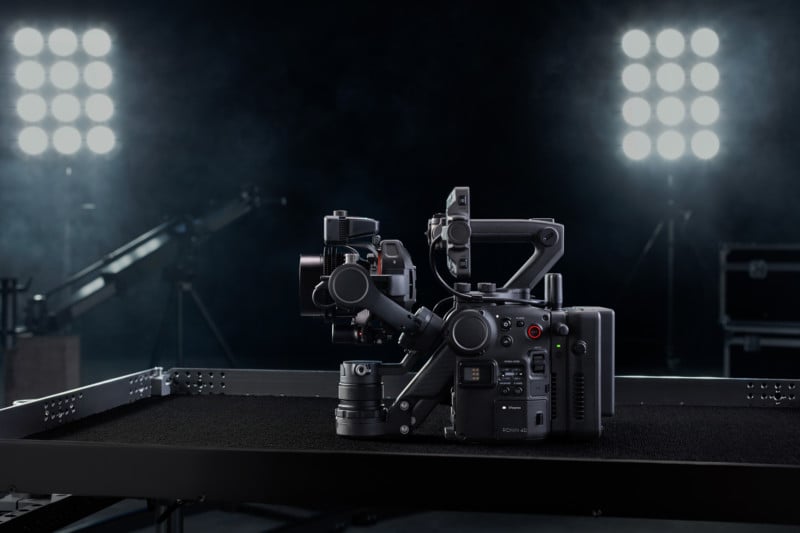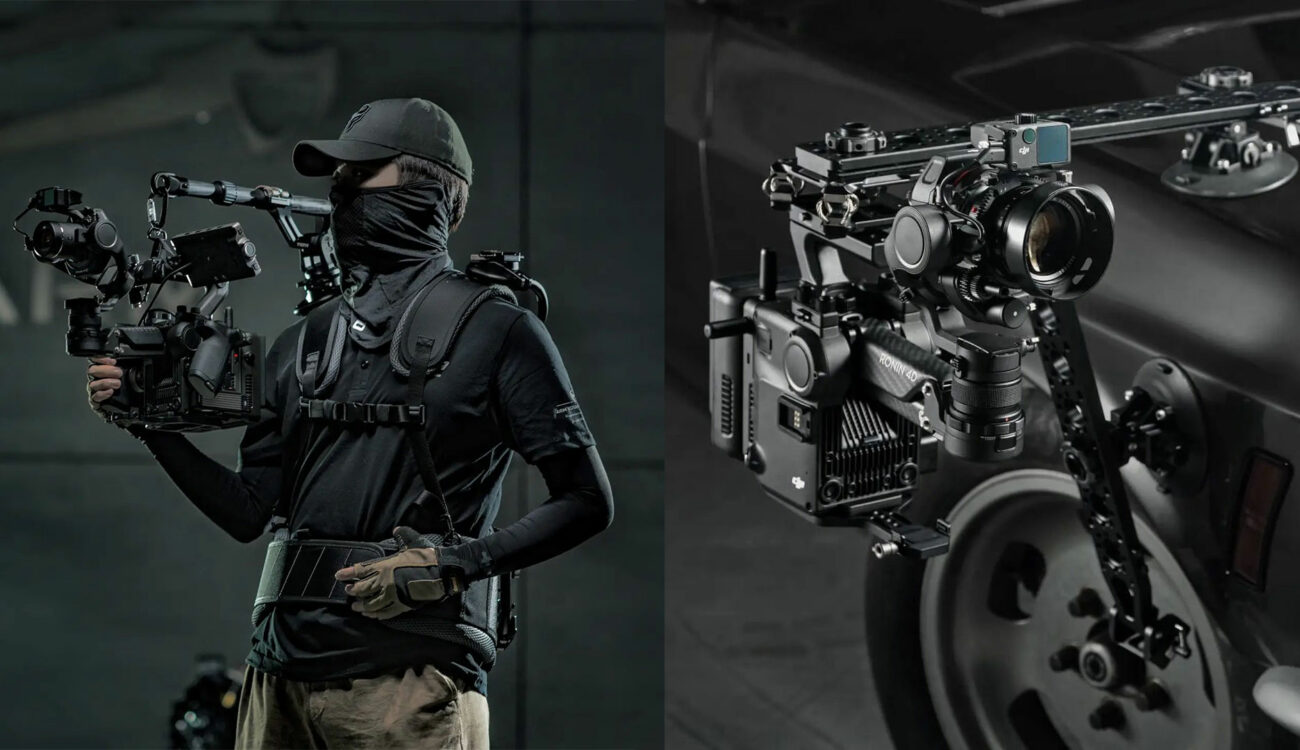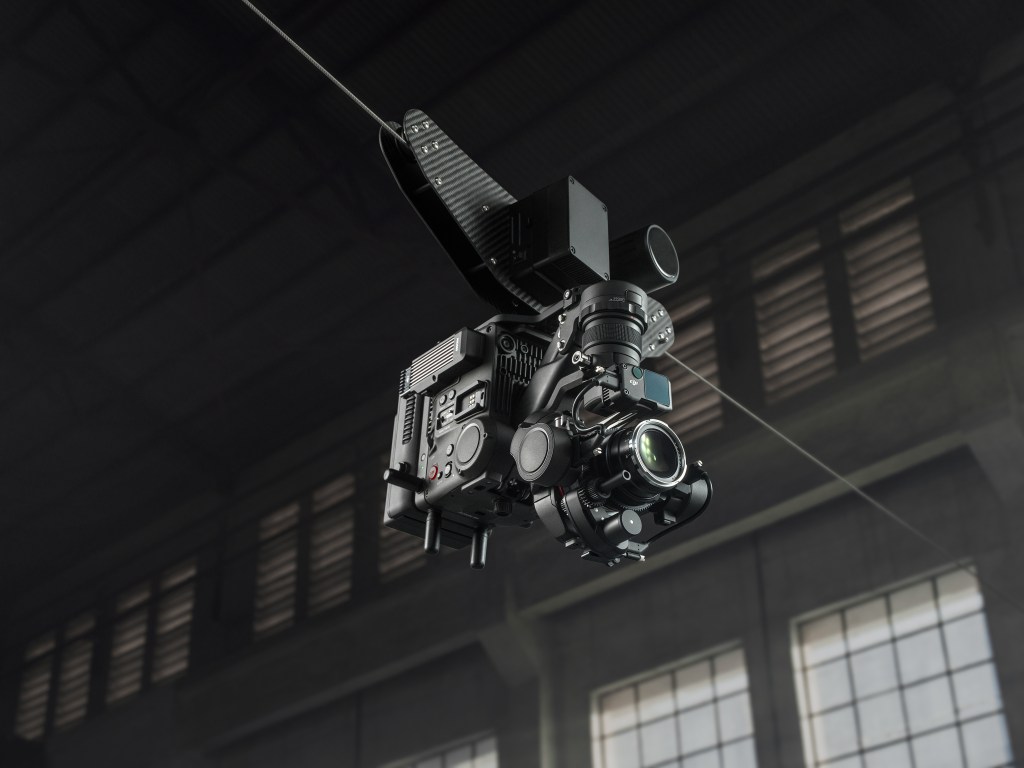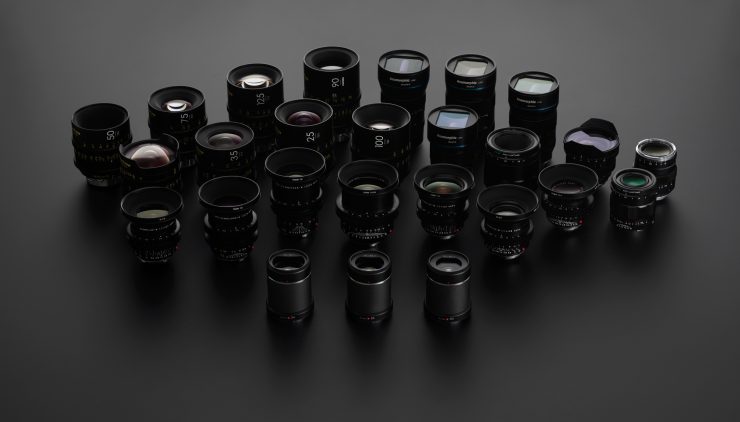Designed for both solo use by independent creators and dynamic pro video capture, the Ronin 4D from DJI is an innovative all-in-one camera/gimbal solution. The “4D” designation refers to the Z-axis (vertical) stabilization built into the X9-8K camera and the three-axis gimbal stabilization.

This system is ideal for independent content producers, indie filmmakers, and event videographers. The full-frame capture at rates up to 8K30 in ProRes HQ and 8K75 in ProRes Raw and Ronin’s CineCore 3.0 image processing system with ACES workflow assistance also fills the 4D as a 2nd unit camera for larger cine-style productions.
This combo includes the main Zenmuse X9-8K full-frame video camera and a 3-axis gimbal, plus an array of modular monitor, focusing, and control components. Kit items include a DL lens mount, a LiDAR range finder, one ProSSD 1TB drive, one TB50 battery, a charging hub, and left and right control handgrips.

This innovative camera gimbal combines imaging, stabilization, and focusing in one lightweight, carbon fiber and aluminum/magnesium alloy rig, this combination design reduces your setup time at the start of the day and in between setups and locations The Included modular components are the Left and right control handgrips, ProSSD 1TB media drive, LiDAR range finder, Top Handle and a Baseplate. It also has support for more available components sold separately like the 7″ touchscreen monitor which you will need to use it, a Wireless video transmitter, X9 focus motor, Leica M lens mount and a 3-channel FIZ lens control unit with the CineCore 3.0 Imaging Processing System.
The Zenmuse X9, DJI’s full-frame camera, uses a proprietary chip for advanced processing and high-performance computing. The Ronin 4D uses the CineCore 3.0 system to support internal recording of Apple ProRes Raw, ProRes 422 HQ, and H.264 video. Industry-standard ACES workflow support provide easy compatibility with other cinema cameras

Advanced 4-Axis Stabilization. Selectable Z-axis stabilization reduces unwanted vertical camera movement, especially during dollying moves, Z-axis stabilization built into the camera, 3-axis stabilization in the gimbal, Tilt stabilization uses dual, symmetrical motors
It also has Pan and X (roll) axes with additional stiffness buffering, Downward ToF (time of flight) sensor, Forward and downward-facing dual-vision sensors, Built-in IMU (inertial measurement unit) and barometer, New and improved stabilization algorithm, Zenmuse X9-8K Camera with DL Lens Mount, The D4’s DL lens mount supports DJI’s current selection of lightweight, carbon fiber 16, 24, 35, and 50mm lenses

Full-frame capture with all but the 16mm DL lens. Interchangeable lens mounts available for use with Sony E-mount or Leica M-mount lenses. Supports ultra-wide, f/0.95 large-aperture, electronic zoom, macro, and anamorphic cine lenses.
The DJI Ronin 4D also Captures Raw, 4:22 HQ, and H.264, Captures 8K full-frame raw at rates up to 75 fps in full-frame 2.39:1, Captures up to 5.5K raw at rates up to 60 fps in Super 35 17:9, Capture up to 8K30 ProRes 422 HQ video in 17:9 full-frame, Capture up to DCI 4K60 ProRes 422 HQ or H.264 in 17:9 full-frame or Super35.

It has Dual Native ISO, 800/5000 dual native ISO, EI 200 to 12800 and 14+ stops of dynamic range produce nuanced imaging under a range of lighting conditions. Features like In-Camera ND Filters, Built-in ND.03 to ND2.7 filters let you easily adjust to quickly changing lighting conditions
Especially handy for outdoor shoots with changing cloud cover, Motorized filter system, Carry in “built” mode for easy company move, LiDAR Focus Control with LiDAR (light detection and ranging) system uses up to 43,200 ranging points within a 33′ range.

It has Excellent focusing performance even in low-light environments and the Focus pulling can be viewed graphically, thanks to a built-in depth meter. It is really Intuitive and highly accurate focusing system, Modular LiDAR focusing module attached to the front of the D4 rig.
There are plenty of Autofocus Features that help it get ahead of the competition too. The 4D Maintains focus, even when motion blur is produced by fast-moving subjects, Separately available focus motor for use with manual lenses, Continuous autofocus is compatible with ActiveTrack Pro, a boon for solo operators, Automated Manual Focus

The AMF function (Automated Manual Focus) combines the accuracy of manual focus with the ease of autofocus, Operators can grab the focus wheel of the right handgrip at any time to manually focus. The handgrip focus wheel uses dynamic damping to provide a physical feel for focus changes.
Features like ActiveTrack Pro combine continuous autofocusing with composition adjustment for professional-looking tracking shots out of the gate, ActiveTrack Pro is based on computer vision, deep learning technology, and the computing power of DJI’s CineCore 3.0 imaging system.

With Dual Focus, Iris, and Control Grips, the Right-hand grip has a focus wheel that doubles as a control for main camera adjustments (menus, exposure, etc.) Left-hand grip has a full-range joystick to control pan/tilt; useful when adjusting headroom and more during follow mode for both Single User or Crew-Assisted Operation
The 4D is Designed to counter footsteps from inexperienced gimbal shooters, so you could give anyone the camera and you could expect great film quality stabilization, it also Works equally well with a single grip, dual grips, shoulder supported, or tripod-mounted and Sport mode is available with the touch of a button, accommodating faster-paced action

Use in standard, underslung, jib, and crane setups. \
You’ll also get quite a lot of Media Storage Options and Requires a ProSSD 1TB drive (included) to capture raw footage, the fact that you could use a USB Type-C port for external recording; no reader needed to offload footage is also a thing that shall get you excited, With Integrated CFexpress Type-B card slot, Built-In 5.5″ Touchscreen Monitor
5.5″ 1920 x 1080 monitor, 1000 cd/m² display, Touchscreen control, Audio Recording. Integrated stereo microphones capture dual-channel 24-bit audio, Built-in 3.5mm audio input port, and XLR port via expander plate

Power Options, Each battery provides up to 2.5 hours of capture time and the Batteries charge fully in approximately 1.5 hours.
With all those cool new specs about the DJI Ronin 4D, that is the best camera you could get for 11,500 USD, the new z-axis stabilization with liDAR is the star of the show and could be the primary reason for you to get one! We’d give the green light to get one right away, this camera is worth every penny (when it’s available) if you have the buck for it.
